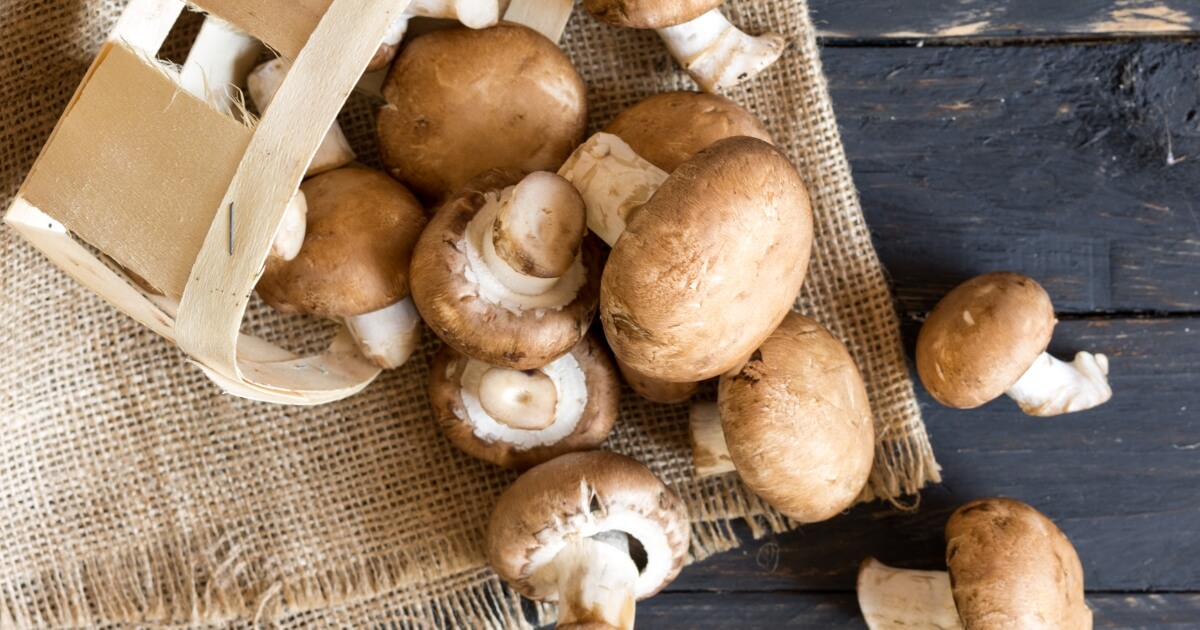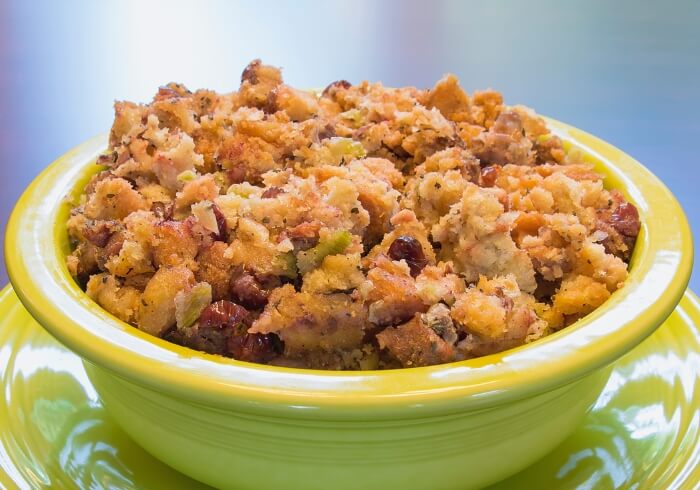If you want to add a delicious burst of flavor to your recipes, then you need to learn how to zest a lemon!
Many recipes call for the zest, but it can be tricky to do it yourself without accidentally grating the bitter white pith.
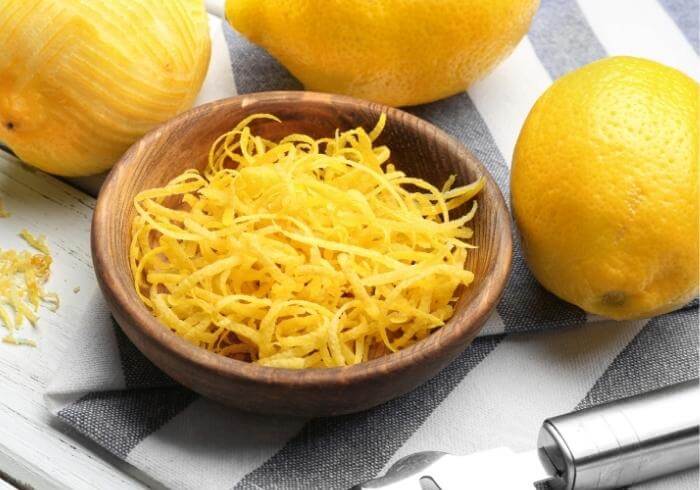
Once you learn how to do it, you can start adding delicious lemon flavor to all sorts of dishes. From chicken and fish to salad dressings and desserts, or just as a garnish, there is almost no limit to the possibilities.
This guide will explain how to zest lemons easily with a Microplane, Grater, and Citrus Zester. Let’s get started!
What Is Lemon Zest?
Lemon zest is the yellow outer layer of the lemon peel. It is an amazing source of citrus flavor and fragrance and where natural oils are derived.
Once the zest is removed, it can be used fresh or stored in the fridge for later use.
What Does Lemon Zest Look Like?
Lemon zest is not to be confused with the entire peel of the lemon. The zest is yellow. The inner white layer of the peel is called the pith which is white in color and is quite bitter.
Below is a lemon that has the zest removed, leaving the pith attached.
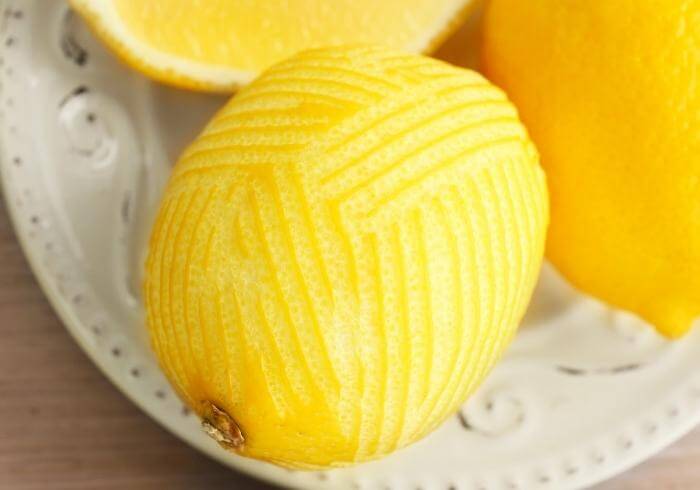
Note: many lemons you buy at the grocery store have a layer of wax that helps preserve them. The wax should be removed before zesting.
How Much Zest Is In One Lemon?
Your average medium-sized lemon will yield 1 tablespoon of zest. Unfortunately, lemons come in various sizes, and you may end up with not enough or too much zest for what your recipe calls for.
If you don’t want to toss the extra zest in the garbage, I always save it for later by putting it in a Ziploc bag, removing the air, and put in the fridge or freezer. The extra lemon itself I juice immediately for some quick lemonade.
What To Use To Zest A Lemon
A Microplane zester removes the zest in very small thin pieces without any of the bitter pith. It’s also much quicker and safer than other methods.
My favorite kitchen tool for zesting a lemon is a Microplane.
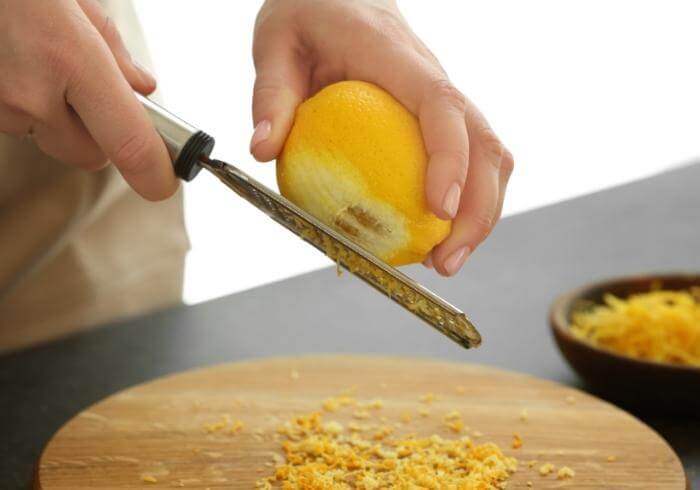
I know it’s another tool to buy, but it can also be used for zesting citrus fruits such as limes, oranges, grating spices, chocolate, hard cheeses, and mincing garlic.
However, many people like using a box grater because it’s something they already have on hand. But unless it has a very fine setting, you’ll end up with zest that is simply too big to toss into your recipe as is.
You might also end up with the pith attached to your zest. Imagine taking a bite out of a lemon blueberry muffin, and suddenly you’re chewing into a piece of bitter leathery lemon peel. Yuck!
A vegetable peeler will also work, but you have to carefully peel the lemon and then use a knife to finely chop your zest.
You can zest a lemon with a knife, but I don’t consider it a good option.
It can be hard to hold while carefully slicing the outer peel. And if the lemon starts leaking lemon juice, it’s going to make things messy, slippery, and just dangerous.
How To Make Lemon Zest
The following instructions are for zesting a lemon using a Microplane, box grater, and zester.
Step 1. Clean Your Lemon
To start, clean one medium lemon thoroughly in or under running water to remove dust and dirt.
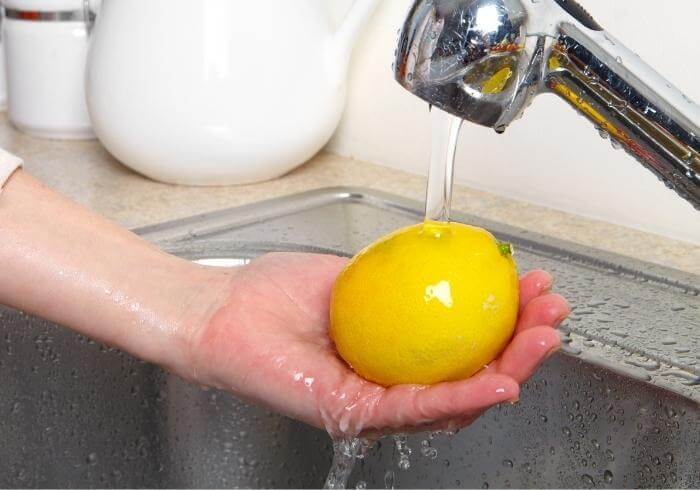
Bonus points if you give it a gentle scrub with a vegetable brush.
You won’t be able to clean your zest afterward, so it’s best to do it right from the start.
Step 2. Dewax Your Lemon (Optional, But Recommended)
This step is optional and also depends on the lemons you have on hand. Some organic lemons do not have a wax coating and simply need to be cleaned before proceeding to the next step.
When you purchase your lemons, if there are no signs or stickers stating that they are unwaxed, ask a produce employee or manager to find out. Generally, waxed lemons have a bit more shine to them.
You can use a vegetable brush to gently remove the wax. Remember that you’re not trying to scrub the yellow off your lemon. I like to scrub lemons under running water to help remove the wax.
Another method to dewax a lemon is to place your lemon in a colander and pour boiling water over it carefully and slowly. Use a silicone mitt or utensil to flip the lemon to the opposite side and repeat with the boiling water.
You’re not trying to cook the lemon, just melt away the wax coating. It’s hard to tell when the wax has been removed from your lemon, but it comes off quickly with boiling water.
If your lemons are real stubborn, they may need a scrubbing while they’re still warm.
Step 3. Rinse And Pat Dry
Keeping your lemon dry on the outside will help prevent a slippery accident.
If you didn’t have to dewax your lemon, simply pat dry.
If you’ve dewaxed your lemon, give it a final rinse with water and pat dry.
Step 4. Prepare Your Work Area
Before you start zesting, you’ll need to place a bowl, dinner plate, or cutting board down to catch the zest.
I think it’s best to do it on top of a cutting board with a damp kitchen towel underneath it to help stabilize and prevent the board from moving.
Step 5. Zest
Remember that you shouldn’t be squeezing the lemon too hard. If you do, the flesh may split and leak juice which can cause things to become slippery.
Using A Grater
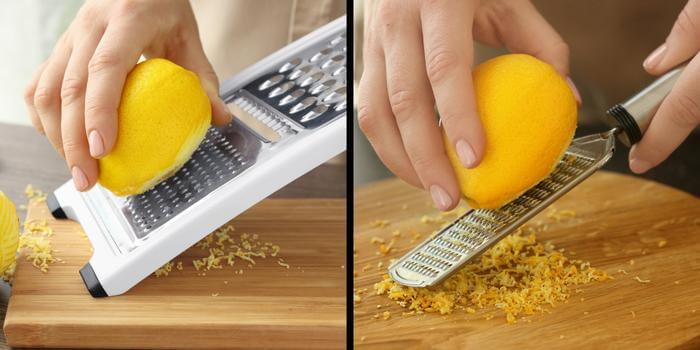
Securely and firmly, hold your tool on the cutting board and move the lemon back and forth over the grates.
Careful not to grate your fingertips.
Using A Microplane

Oops! A little too much zest was taken off.
You may need to hold your tool on an angle in the air if you’re using a Microplane.
I like to do short quick strokes to remove only the yellow part of the peel and check the lemon often to make sure that I’m not removing the white pith with the zest.
If your grater produces large pieces too big for your needs, mince it finely with a knife.
Using A Lemon Zester

Hold your lemon in one hand and carefully scratch the lemon with long, deliberate strokes. It’s very similar to using a vegetable peeler but will yield long, thin pieces of zest.
When you’ve scraped off enough zest, or the lemon doesn’t have any left, don’t throw your lemon away. Set it aside for another recipe.
Step 6. Use Immediately Or Store For Later
Use your fresh lemon zest immediately or store it for later. If you’re not going to use it within a couple of hours, wrap it in plastic wrap tightly.
It should last 2 to 3 days in the fridge and up to 6 months in the freezer. You can tell your lemon zest has gone bad when it starts to become brown.
Step 7. Add Lemon Zest To Your Recipe
Add your lemon zest to your favorite recipe.
Lemon Zest FAQs
How To Get Lemon Zest Off Grater?
If lemon zest is stuck in your grater, carefully bang the grater on the side with your hand or gently bang it on your cutting board to free it. When cleaning, swish it in water or use a brush to loosen it.
Can I Zest A Lemon With A Cheese Grater?
Yes, you can zest a lemon with a cheese grater, but not all box graters have a fine setting. In that case, you will need to process the zest further by mincing it with a knife.
Can I Zest A Lemon Without A Zester Or Grater?
Yes, you can get lemon zest by carefully slicing thin layers off a lemon with a knife and then finely chopping the slices. This is my least favorite method because slicing a round object can be very dangerous.
Is Lemon Zest Acidic?
The zest of a lemon is mildly acidic compared to lemon juice but still retains much of the lemon flavor and aroma we look for.

How To Zest A Lemon
Equipment
- 1 Citrus zester (Substitute with Microplane or Box Grater)
- 1 Bowl
- 1 Cutting board
Ingredients & Supplies
- 1 Medium Lemon
Instructions
Clean Your Lemon
- Wash your lemon under running water to remove any dirt or debris. Use a vegetable brush to give it a good scrub.
- Give a final rinse and pat dry.
Remove Wax From Lemon
- If your lemon has a wax coating, place in a colander, carefully pour boiling water over it slowly for 10 seconds.
- Use a silicone glove or mitt to rotate the lemon to the other side and repeat.
- Give a final rinse with cool water and pat dry.
Zesting With Grater or Microplane
- Hold your grating tool securely with one hand against your cutting board. If using a microplane, you may hold it in the air if you are strong enough.
- Move the lemon across the grates with the other hand with short quick strokes.
- Check and rotate the lemon to avoid grating the pith.
Zest With Citrus Zester
- Hold your lemon in one hand and zester in the other.
- Use the zester to scratch or peel the zest like when using a vegetable peeler.
- Collect lemon zest and add to a bowl.
Final Step
- Use immediately or store for later.



